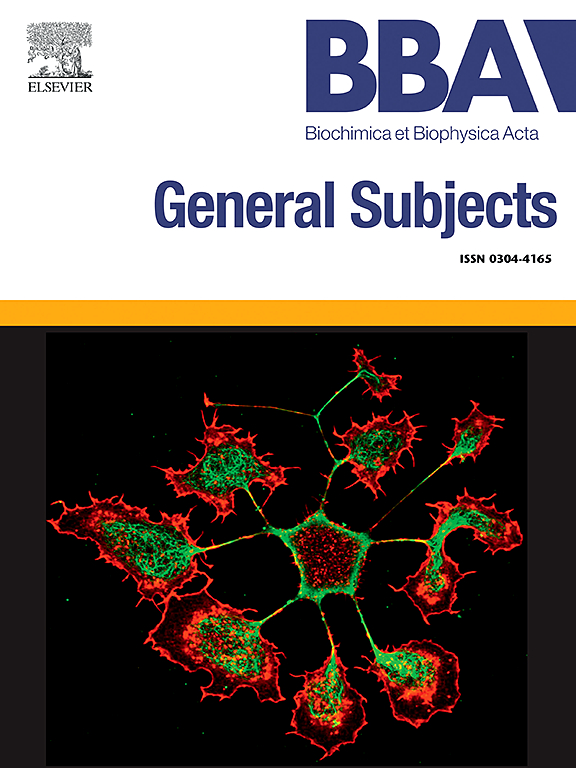Analysis of lipids by Raman spectroscopy and mass spectrometry provides a detection tool and mechanistic insight into imatinib resistance in CML-BC
IF 2.2
3区 生物学
Q3 BIOCHEMISTRY & MOLECULAR BIOLOGY
Biochimica et biophysica acta. General subjects
Pub Date : 2025-02-10
DOI:10.1016/j.bbagen.2025.130771
引用次数: 0
Abstract
Resistance to tyrosine kinase inhibitors (TKIs) is a major challenge in the treatment of chronic myeloid leukemia (CML). Established tests based on the known mechanisms of resistance in the initial chronic phase (CP) confirm resistance, reveal the underlying reason and thereby direct treatment modifications. In the terminal phase of blast crisis (BC), however, additional partially identified mechanisms of resistance exist which necessitates developing modalities to detect resistance regardless of the underlying mechanism and concurrent exploration of the resistance mechanism to assist in identification of appropriate drug targets. In this study both the clinical objectives were achieved by analysing lipids in BC cells, sensitive and resistant to TKIs, using the complementary strengths of distinct analytical technologies.
Raman spectroscopy, through the spectral signatures with lipids as a significant differentiating component could segregate resistant from sensitive cells in the Principal Component Analysis (PCA) and Principal Component based Linear Discriminant Analysis (PC-LDA). This provided a tool to rapidly detect resistance in CML-BC despite unclear mechanism of TKI resistance. The depth of coverage achievable by mass spectrometry allowed the generation of quantitative differential profile of individual lipids in resistant cells. The alterations were in diverse classes of lipids which are involved in cell signalling and inhibition studies could link these alterations to modulation of phospholipase A2 (PLA2) levels mediated by p38 mitogen activated protein kinase (p38MAPK), which is causally associated with TKI resistance in CML-BC. Together, lipid analysis using the two platforms, contributed to the detection and mechanistic understanding of imatinib resistance in CML-BC.

通过拉曼光谱和质谱分析脂质为CML-BC的伊马替尼耐药提供了检测工具和机制洞察。
对酪氨酸激酶抑制剂(TKIs)的耐药性是慢性髓性白血病(CML)治疗的主要挑战。基于已知的初始慢性期(CP)耐药机制的既定测试证实了耐药,揭示了潜在原因,从而指导了治疗修改。然而,在blast crisis (BC)的终末阶段,存在额外的部分确定的耐药机制,这就需要开发出检测耐药的方法,而不考虑潜在的机制,同时探索耐药机制,以帮助确定适当的药物靶点。在这项研究中,通过分析BC细胞中的脂质,利用不同分析技术的互补优势,对TKIs敏感和耐药,实现了两个临床目标。在主成分分析(PCA)和基于主成分的线性判别分析(PC-LDA)中,拉曼光谱通过以脂质为重要区分成分的光谱特征可以区分耐药细胞和敏感细胞。这为快速检测CML-BC的TKI耐药机制提供了一种工具。质谱法覆盖的深度允许在耐药细胞中产生单个脂质的定量差异剖面。这些改变发生在不同类型的脂质中,涉及细胞信号传导和抑制研究,可以将这些改变与p38丝裂原活化蛋白激酶(p38MAPK)介导的磷脂酶A2 (PLA2)水平的调节联系起来,p38丝裂原活化蛋白激酶(p38MAPK)介导的磷脂酶A2 (PLA2)水平的调节与CML-BC的TKI抗性有因果关系。总之,使用这两个平台的脂质分析有助于CML-BC中伊马替尼耐药的检测和机制理解。
本文章由计算机程序翻译,如有差异,请以英文原文为准。
求助全文
约1分钟内获得全文
求助全文
来源期刊

Biochimica et biophysica acta. General subjects
生物-生化与分子生物学
CiteScore
6.40
自引率
0.00%
发文量
139
审稿时长
30 days
期刊介绍:
BBA General Subjects accepts for submission either original, hypothesis-driven studies or reviews covering subjects in biochemistry and biophysics that are considered to have general interest for a wide audience. Manuscripts with interdisciplinary approaches are especially encouraged.
 求助内容:
求助内容: 应助结果提醒方式:
应助结果提醒方式:


